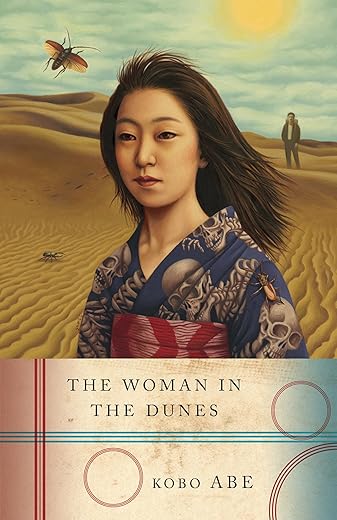
$5.25
The Woman In The Dunes Price comparison
The Woman In The Dunes Price History
The Woman In The Dunes Description
The Woman In The Dunes: Explore a Literary Masterpiece
“The Woman In The Dunes” is one of the most captivating works by Japanese author Kōbō Abe. This profound novel, published by Vintage in a reissue edition on December 14, 2011, intertwines themes of isolation, the human condition, and the quest for identity. Whether you’re a literature enthusiast or a casual reader, this book offers a compelling narrative that resonates deeply. If you’re looking for “The Woman In The Dunes” price comparisons or reviews, you’ve come to the right place!
Main Features and Benefits
- Engaging Narrative: Experience a haunting tale of a man trapped in a remote sand dune village, exploring existential themes and societal constraints.
- Rich Language and Style: Enjoy the nuanced prose of Kōbō Abe, which draws readers into a world where the struggle against nature reflects human inner turmoil.
- Enhanced Reading Experience: The book supports Text-to-Speech, making it accessible for visually impaired readers and enhancing your reading experience.
- Well-Organized Structure: With a print length of 258 pages, the novel is designed for both ease of reading and profound engagement.
- Availability Across Platforms: The book’s digital format (3873 KB file size) ensures you can read it on multiple devices, offering convenience and accessibility.
Price Comparison Across Different Suppliers
In our price comparison analysis, “The Woman In The Dunes” is available through various suppliers, each offering competitive pricing. Here’s a quick overview of the pricing trends:
- Amazon: Competitive rates often featuring discounts and promotions.
- Local bookstores: Price may vary but often offers personalized service.
- eBook platforms: Digital copies frequently have lower prices, especially in sales.
We encourage you to compare prices to find the best deal that suits your reading preferences!
6-Month Price History Insights
According to the 6-month price history chart, the cost of “The Woman In The Dunes” has seen fluctuations, reflecting seasonal sales and promotions. Notably, significant drops often align with literary festivals or special events. Keeping an eye on this data can help you snag the book at the best price.
Customer Reviews: What Readers Are Saying
Overall, customer reviews for “The Woman In The Dunes” reveal a mix of admiration and critique:
- Positive Aspects: Many readers praise Abe’s masterful storytelling and complex themes that provoke thought and reflection. They appreciate the way the narrative delves into the intricacies of human relationships and societal pressures.
- Noted Drawbacks: Some reviewers mention that the pacing can feel slow, especially in the beginning. A few readers found the surreal elements challenging to digest, hinting that this book might not appeal to everyone.
Related Unboxing and Review Videos
For a deeper dive into “The Woman In The Dunes,” we recommend checking out some engaging unboxing and review videos on YouTube. These videos provide insights from fellow readers and can enhance your understanding of the book’s themes and narrative style. Watching these clips is an excellent way to gauge whether this novel suits your literary tastes.
In summary, “The Woman In The Dunes” by Kōbō Abe is more than just a book; it’s an exploration of the human experience captured through striking prose. Whether you’re searching for “The Woman In The Dunes” price or detailed reviews, this guide serves to inform and assist you. Don’t miss the chance to own this literary gem!
Compare prices now!
The Woman In The Dunes Specification
Specification: The Woman In The Dunes
|
The Woman In The Dunes Reviews (8)
8 reviews for The Woman In The Dunes
Only logged in customers who have purchased this product may leave a review.













Humungus –
I’ve read many Yukio Mishima books and love them, this book reminds me of his work. It has elements of existentialism to it, for me – the main character’s entrapment speaks to me about my own entrapment of daily life – most of all the drudgery of work – supposedly it’s all a choice but it doesn’t feel like it if you have debts and are tied to a salary.
Anyway, I highly recommend this book to readers of Mishima or the likes. There is also a film adaption that is very good too.
Harry –
This book can be read at so many levels – existentialism of course, after all `what is the use of individuality when one is on the point of death?’ And what is life in a sand hole – `terrifyingly repetitive. One could not do without repetition in life, like the beating of the heart, but it was also true that the beating of the heart was not all there was to life.’ Or perhaps read it is an allegory for post-war Japan, a Japan consumed by work, where people lived in their boardinghouse holes, craving freedom, but overwhelmed by the remorseless sands of capitalism and consumerism. Or maybe as a tale of soul-destroying horror, resignation and love. Form your own view, there are many facets to this story.
And in producing the story, Kobo Abe proves to be a fine prose-meister- the dunes are a place of horror, a place where the woman `existed only for the purpose of clearing away the sand,’ but they are also a place `where sunlight lay scattered in needlepoints of light … [where] a milky mist billowed and swirled above the cliff, spaces of shadow, speckled with the remains of night … spaces flowing with particles of shining vapour … the combination of shadows was filled with fantasies … every moment overflowed with new discoveries, everything was there, actual shapes confounded with fantastic forms never seen before.’ And life in the hole in the sand can be felt and tasted, the grinding all pervading grit, the strange parched world of burning heat, swathed in sea mist at night and rising, rotting damp. A sorrowful place, a place where `they might as well lick each other’s wounds. But they would lick forever, and the wounds would never heal, and in the end their tongues would be worn away.’
Amongst the prose, Abe provides a description of entomologists bound to draw their ire (or perhaps a direct and accurate hit) – extremely reclusive, kleptomaniac, homosexual, with suicide the next step. Our entomological protagonist, Niki Jumpei, managed to break free of Abe’s stereotype – homosexual he was not, sexual fantasies were more his thing (and Freud would have had a field day with his fantasies and hallucinations); and nor was he suicidal, showing a grim determination to hang on to life in his hell-hole in the dunes. Maybe he broke the mould through his broader interest – the sand which was `ceaselessly moving and inhospitable to all living things.’
All up a fascinating book that will, in due course, warrant further reading and delving into those dark places explored by Kobo Abe.
Faren –
One of the best books I’ve ever read.
It felt eerie and creepy without any climax to confirm these feelings, making you feel unsettled in a long lasting way.
This book was not written in my time period or country but it is still relatable.
An amazing piece of art
Gabriella Gallo –
Hard to put down and easy to read, would recommend
raine –
You will remember the size of sand for the rest of your life if you read this.
Rohit Rawat –
Not a book review. Quality is amazing. Print and Font size is good.
Max Read –
Kobo Abe (1924 -1993); his given name was Kimifusa which with a Chinese type pronunciation became Kobo. Abe’s father was a physician and Abe trained as a physician, although he never became a doctor but instead pursued writing and a keen interest in entomology. In 1951, Abe received the most important Japanese literary prize, the Akutagawa Award, for his novel The Crime of Mr. S. Karuma. In 1960 his novel The Woman in the Dunes won the Yomiuri Prize for Literature. It was made into a film by Hiroshi Teshigahara in 1963 and won the jury prize at the Cannes Film Festival. Abe dedicated most of his later career to writing plays and directing his own theatre troupe in Tokyo until his death in 1993.
The story of The Woman in the Dunes is told by an anonymous narrator. The writing is straight forward and not complex in its construction. The details of the tale are at times interwoven with philosophical musing, a result of the plight of the protagonist as he would see it and something that leads the reader to witness all the steps taken by the protagonist to rationalize his situation. This aspect of the writing appears to be aesthetically polarizing; some will like it but not quite know why, and some will dislike it and not quite know why. Identification is another role that seemingly plays out in Abe’s work; many a reader will find resemblances to the hapless insect collector and his doomed life of repetitively performing a monotonous activity. In many ways Abe’s composition examines the stages of psychosis of the imprisoned; captives who first find their circumstances unreasonable and who linger over the injustice with only thoughts of escape – finally to eventually accept their plight, adjusting their image of circumstances to reflect normalcy, even feeling friendship to their captors as time goes on and escape becomes hopeless.
The tale itself is about a young teacher, an amateur entomologist, who departs one day for an outing to a sea side area of the country in search of a particular beetle that he believes he will find in the sand dunes there. As the story unfolds, we find the hapless young man encountering the inhabitants of a strange village built in the sands, whereupon he is unwittingly deceived into being lowered to a house, occupied by a lone woman, at the bottom of a sand basin; he soon realizes there is no subsequent escape and that the ever falling sand must be shoveled into containers for removal each day lest it overtake and bury the house and its inhabitants.
I had mixed emotions about Kobo Abe’s work. I liked the emotional tenseness produced of the circumstances of unjust captivity, but at the same time, I felt the strangeness of the environment to make the composition seem otherworldly. Further, I didn’t always appreciate the musing provided by the protagonist – it seemed detached. As to the character of the protagonist, he also was a strange one, for he seemed to be quite intelligent and inventive, yet clumsy and inept at the same time; the dichotomy was exasperating especially because it foiled his escape.
All in all, I liked the story of The Woman in the Dunes in spite of some of the bothersome aspects.
I would recommend you add this novel to your reading list and rate it “Pleasurable-not memorable”.
Rohit Rawat –
Bought this book after seeing the adaptation to film by Teshigahara. Excellent book, the illustrations inside where a nice surprise!